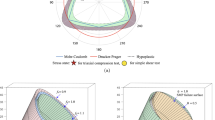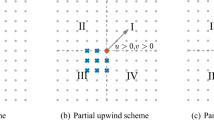Abstract
A quasi-nodal discontinuous Galerkin (DG) model employs monotonicity preserving Bernstein polynomials as basis functions in combination with an efficient vertex-based slope limiter. As opposed to classical nodal Lagrange DG models, it simulates flooding and drying stably even with higher than second-order basis functions. We study the viability of the latter for inundation simulations in general and discuss the quality of the new basis functions. A subsequent numerical study demonstrates the conservation properties and local convergence rates of the new method.





Similar content being viewed by others
References
Ainsworth M, Andriamaro G, Davydov O (2011) Bernstein-bézier finite elements of arbitrary order and optimal assembly procedures. SIAM J Sci Comput 33(6):3087–3109. doi:10.1137/11082539X
Aizinger V (2011) A geometry independent slope limiter for the discontinuous Galerkin method. Comput Sci High Perform Comput IV NNFM 115:207–217
Behrens J, Rakowsky N, Hiller W, Handorf D, Läuter M, Päpke J, Dethloff K (2005) amatos: parallel adaptive mesh generator for atmospheric and oceanic simulation. Ocean Model 10(1–2):171–183. doi:10.1016/j.ocemod.2004.06.003
Bernard PE, Remacle JF, Comblen R, Legat V, Hillewaert K (2009) High-order discontinuous Galerkin schemes on general 2D manifolds applied to the shallow water equations. J Comput Phys 228(17):6514–6535. doi:10.1016/j.jcp.2009.05.046
Bunya S, Kubatko E, Westerink J, Dawson C (2009) A wetting and drying treatment for the Runge–Kutta discontinuous Galerkin solution of the shallow water equations. Comput Methods Appl Mech Engrg 198:1548–1562
Dawson C, Kubatko EJ, Westerink JJ, Trahan C, Mirabito C, Michoski C, Panda N (2011) Discontinuous Galerkin methods for modeling Hurricane storm surge. Adv Water Resour 34:1165–1176
Farin G (1986) Triangular bernstein-bezier patches. Comput Aided Geom D 3:83–127
Giraldo FX, Warburton T (2008) A high-order triangular discontinuous Galerkin oceanic shallow water model. Int J Numer Meth Fluids 56:899–925
Giraldo FX, Hesthaven JS, Warburton T (2002) Nodal high-order discontinuous Galerkin methods for the spherical shallow water equations. J Comput Phys 181:499–525. doi:10.1006/jcph.2002.7139
Hesthaven JS (1998) From electrostatics to almost optimal nodal sets for polynomial interpolation in a simplex. SIAM J Numer Anal 35:655–676. doi:10.1137/S003614299630587X
Hesthaven JS, Warburton T (2008) Nodal discontinuous Galerkin methods: algorithms, analysis, and applications. Springer, Berlin
Hindenlang F, Gassner G, Bolemann T, Munz CD (2010) Unstructured high order grids and their application in discontinuous Galerkin methods. Preprint Series, Stuttgart Research Centre for Simulation Technology (SRC SimTech) issue no, pp 2010-26
Kirby R, Thinh K (2012) Fast simplicial quadrature-based finite element operators using Bernstein polynomials. Numer Math 121:261–279
Kuzmin D (2010) A vertex-based hierarchical slope limiter for p-adaptive discontinuous Galerkin methods. J Comput Appl Math 233:3077–3085
Kuzmin D (2013) Slope limiting for discontinuous Galerkin approximations with a possibly nonorthogonal Taylor basis. Int J Numer Methods Fluids 71:1178–1190
Loubére R, Ovadia J, Abgrall R (2004) A Lagrangian discontinuous Galerkin-type method on unstructured meshes to solve hydrodynamics problems. Int J Numer Meth Fluids 44:645–663
Müller A, Behrens J, Giraldo F, Wirth V (2013) Comparison between adaptive and uniform discontinuous Galerkin simulations in dry 2D bubble experiments. J Comput Phys 235:371–393
Rusanov VV (1962) Calculation of interaction of non-steady shock waves with obstacles. NRC, Division of Mechanical Engineering
Thacker WC (1981) Some exact solutions of the nonlinear shallow-water wave equations. J Fluid Mech 107:499–508
Toro EF (2001) Shock capturing methods for free-surface shallow flows. Wiley, New York
Vater S (2013) A multigrid-based multiscale numerical scheme for shallow water flows at low Froude number. PhD thesis, Freie Universität Berlin. http://www.diss.fu-berlin.de/diss/receive/FUDISS_thesis_000000093897
Vater S, Beisiegel N, Behrens J (2015) A limiter-based well-balanced discontinuous Galerkin method for shallow-water flows with wetting and drying: one-dimensional case. Advances in Water Resources Under review
Westerink JJ, Luettich RA, Feyen JC, Atkinson JH, Dawson C, Roberts HJ, Powell MD, Dunion JP, Kubatko EJ, Pourtaheri H (2008) A basin- to channel-scale unstructured grid hurricane storm surge model applied to Southern Louisiana. Mon Weather Rev 136:833–864. doi:10.1175/2007MWR1946.1
Xing Y, Zhang X (2013) Positivity-preserving well-balanced discontinuous Galerkin methods for the shallow water equations on unstructured triangular meshes. J Sci Comput 57:19–41
Xing Y, Zhang X, Shu C (2010) Positivity-preserving high order well-balanced discontinuous Galerkin methods for the shallow water equations. 33(12):1476–1493. doi:10.1016/j.advwatres.2010.08.005
Acknowledgments
The authors gratefully acknowledge support through the Cluster of Excellence ‘CliSAP’ (EXC177), University of Hamburg, funded through the German Science Foundation (DFG), as well as through ASTARTE—Assessment, STrategy And Risk Reduction for Tsunamis in Europe. Grant 603839, 7th FP (ENV.2013.6.4-3). The second author also acknowledges support through Advanced Simulation of Coupled Earthquake and Tsunami Events (ASCETE) funded by the Volkswagen foundation. Furthermore, the authors would like to thank the anonymous reviewers for their kind consideration and comments that helped improve the manuscript.
Author information
Authors and Affiliations
Corresponding author
Rights and permissions
About this article
Cite this article
Beisiegel, N., Behrens, J. Quasi-nodal third-order Bernstein polynomials in a discontinuous Galerkin model for flooding and drying. Environ Earth Sci 74, 7275–7284 (2015). https://doi.org/10.1007/s12665-015-4745-4
Received:
Accepted:
Published:
Issue Date:
DOI: https://doi.org/10.1007/s12665-015-4745-4




